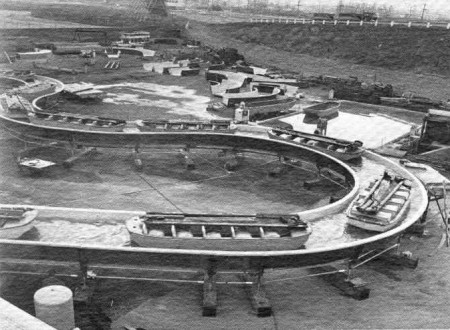|
Mission Impossible
The last of the World's Fair projects
to be undertaken, and perhaps the most stunning Disney achievement
for the Fair, was "It's A Small World." Pepsi-Cola,
who was working with UNICEF, the United Nations agency for children's
welfare, was looking for an attraction that would provide a "salute
to UNICEF and all the world's children."
Pepsi executives went to California
to request the help of Disney. When Walt told Pepsi that he would
take the challenge of doing their Pavilion, only a little more
than twelve months were left before the opening of the Fair.
He immediately went into light speed, wasting no time in getting
the contracts and agreements concluded. The easy part was done!
Walt went to meet with his Imagineers,
who were immersed in their work on the other three Pavilions,
to let them know the "good news." They thought he was
crazy. "One day Walt pulled all of the show designers in,
and he said, "There's one more piece of real estate that
they've offered to us. And I've got this idea for a little boat
ride that maybe we can do," remembered Rolly Crump. "And
we thought, a little boat ride? I mean God, we were working
on Lincoln, the Carousel of Progress, both of which were using
the highest technology and animatronic figures. And we were working
on Ford, too. All of this and Walt wants to do a little boat
ride!
While the show designers sat around
the table with their mouths agape, Walt told them that he wanted
the boat ride to feature the children of the world, offering
a salute to UNICEF. When the meeting was over, the talented group
left with their assignment - to generate concepts and ideas for
Walt's little boat ride.
The boat ride "system"
had already been in the development stages at the time of Walt's
meeting. Arrow Manufacturing in Mountain View, California, had
been working on a system based on an outline by Bob Gurr. Gurr
recalls, "Arrow was trying to get a boat ride figured out,
and I remember discussing it with them. I drew up a configuration
for a trough that had a center-post wheel in it that they used.
And they figured out all the water pump stuff. Then all of a
sudden that boat was adopted for the Small World ride."
Arrow Manufacturing's "test
track" for the system that would eventually propel "the
happiest cruise that ever sailed."
SOURCE: 20th
Anniversary New York World's Fair 1964-1965 - A Disney Retrospective
© 1984 Walt Disney Productions
 |
A very simple L-shaped building with
an asphalt floor was quickly designed, with hardly the slightest
idea of what would be installed inside. Hot off the drafting
table, the plans for the 32,000 square foot structure were sent
to New York. "It was just a corrugated barn," offered
Crump. "It looked like aluminum, but it was just cheap,
plastic corrugated siding. It was the ugliest building you ever
saw in your life."
Not even a month had gone by since
Walt had accepted Pepsi's invitation, and he already had his
show designers working on concepts, a boat-ride system for the
Pavilion, and plans for the building in New York, with construction
to begin soon. It was a masterful start to what appeared like
an impossible mission.
Joan Crawford to
the Rescue
... [P]reliminary ideas ... were
put together ... and [flown] out to Pepsi's headquarters in New
York for a presentation. Pepsi's board of directors watched with
a detached interest [as they were] told of the preliminary plans
for the happiest cruise that ever sailed. When [the presentation
was] finished, most of the board reacted in a negative manner,
asking such questions as, "Why do we need this Mickey Mouse
thing?"
The reaction illustrates why Pepsi
approached Disney so late in the game. "They couldn't get
to first base with any designer or anything," recalled Bob
Gurr. "Finally, a year after they should have started, they
approached us." Joan Crawford, the film actress, was on
the board of directors for Pepsi. She knew that Disney was working
on three Pavilions, so it was under her suggestion that Pepsi
approached Disney.
It was only about ten months from
the opening of the Fair, and Pepsi's board of directors was about
to make the same mistake it had made with the previous designers;
they were going to derail the concept. Joan Crawford had seen
enough. She stood up, and with the talents acquired from years
of playing leading ladies in Hollywood, she emphatically informed
the board that, "We are going to do this!"
|